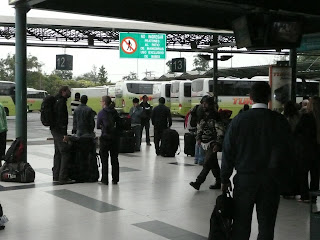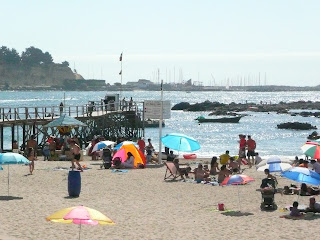We flew to Santiago from San Francisco without incident. Our previous arrangements all worked as planned. We had rented an apartment in Providencia for two months, and made this arrangement when we were in Santiago earlier in 2010.
Providencia is one of many comunas, or municipalities, that make up the Santiago greater area. Santiago itself is the historic center. Each comuna is self-governing, so the set-up is a bit like Los Angeles in many regards, except that there isn’t one big city with all the satellites. Providencia, Las Condes, Vitacura, and the other comunas to the east are rather well-to-do.
Above is La Moneda, the presidential office building. It dates from about 200 years ago, and looks very typical of late colonial Spanish buildings. Notice the more modern building across the street. La Moneda was extensively refurbished after the Chilean Air Force bombed it on 11 September 1973 during the overthrow of President Salvador Allende. We were fortunate to tour this building, and later to meet with Sra. Ena von Baer, the presidential spokeswoman. Ena is a sister of Karina von Baer, our friend from Gorbea that we first met on a train from Mongolia to China.
Penny and one of the duty Carabineros at La Moneda.
The apartment is on Avenida Francisco Bilbao, near the Bilbao metro station on Avenida Tobalaba. It is convenient to a medium-sized Santa Isabel supermarket a few blocks away, and to a larger Jumbo supermarket a litter farther in the other direction. All the conveniences of home, which of course, was exactly the idea.
Santiago was listed as the Number One of 41 places to visit in 2011, as written in the travel section of the New York Times. It has been quite nice temperature-wise. Because it is trapped in a valley between the coastal mountains to the west and the Andes to the east, the pollution can be bad. Penny was sick for the first week we were here, and the smit and viz in the air probably contributed to that. On many weekdays, the haze is so bad that we can’t see the coastal range from our window, and those mountains are not very far away.
This day is actually rather clear, although there is quite a bit of pollution. Sometimes we can't see the mountains in the background at all.
We had visitors and saw friends, of course. This was the first Christmas since we have had children that Penny, David, and Charles were not together. Andreas and Karina invited us to their farm in Gorbea, 700 km south of Santiago, near the city of Temuco. We had a great time there, as you can see from the pictures here. Bruce thinks, right now, that to leave the United States during the Christmas holiday season was possibly not such a good idea.

We went from Santiago to Gorbea by bus. Bus and train stations are fascinating places, with people coming and going, to and fro, at all hours of the day. TurBus operates mostly from the Terminal Alameda, above, which is a few blocks from the Estacion Central that serves most of the bus lines. If you are from California, then you may think you are home as the bus runs down Ruta 5 Sur (Route Five South), passing towns with names like San Francisco and Los Angeles. Actually, it looks more like 99 than 5, because the agribusinesses are right by the roadside. But the farmland, agribusiness, and mountains on either side look just like the San Joaquin Valley.
Andreas Shick and Karina von Baer have a fundo, or large farm, in the south of the Chilean valley. He is from Germany, and she is Chile-born of German immigrant extraction. Their house is like a little enclave of Germany, as you can see from these pictures.
They had a large Christmas tree, which they put up on Christmas eve.
Karina is a wonderful friend and a great hostess. This is the Christmas Eve dinner table.
Andrecito, Karina, and Andreas. Note Andrecito's costume, and Andreas's Bavarian jacket.
Also included here are some pictures from other places in Chile. Some of them were taken during earlier visits, and you can see what a typical Chilean town looks like. Except for Viña del Mar, which is a famous coastal resort and looks more prosperous.
Gorbea has its Plaza de Armas, and also typical side streets.
Karina started a processing plant to produce canola oil for internal sale and for export.
Plaza Mayor in Viña del Mar.
Monument in Viña del Mar to world-renowned Chilean poets Pablo Neruda and Gabriela Mistral.
Casablanca is a fairly prosperous town in a wine producing area just west of Santiago. The Plaza de Armas is always a most attractive aspect of any town, but the adjacent streets are often not so picturesque.
Mapuche style statue in Casablanca's Plaza de Armas.
Penny and her new friend, Iñaki, in Viña del Mar.
Through a connection of Karina’s, we were able to spend a week in a beach apartment in Algarrobo, a beach resort on the coast south of Valparaiso. It is quite pleasant, but not a place that in itself, would merit coming to Chile. If you are already here, then this is a place to visit. But it isn’t like Buzios in Brazil, Waikiki, or the south of France. That can be a plus! All in all, Bruce still prefers Dennisport, Massachusetts!

Erika and Elke were with us for the Algarrobo visit. Erika returned to Gorbea, and Elke flew home to Vienna right afterward. We were able to make several day trips. One was down the coast to Isla Negra, the site of one of poet Pablo Neruda’s homes. No pictures were allowed inside, but we got some good ones outside. In its style and décor, Isla Negra was very much like La Chascona, Neruda’s Santiago home. Very nautical…in the way that only a landlubber fascinated by the sea could do. One that had the ability to collect lots of things such as ships’ instruments, figureheads, etc. etc. I don’t mean to cast dispersions. But, you would never catch me painting my house haze gray outside, and inside with white walls and dark green baseboards.